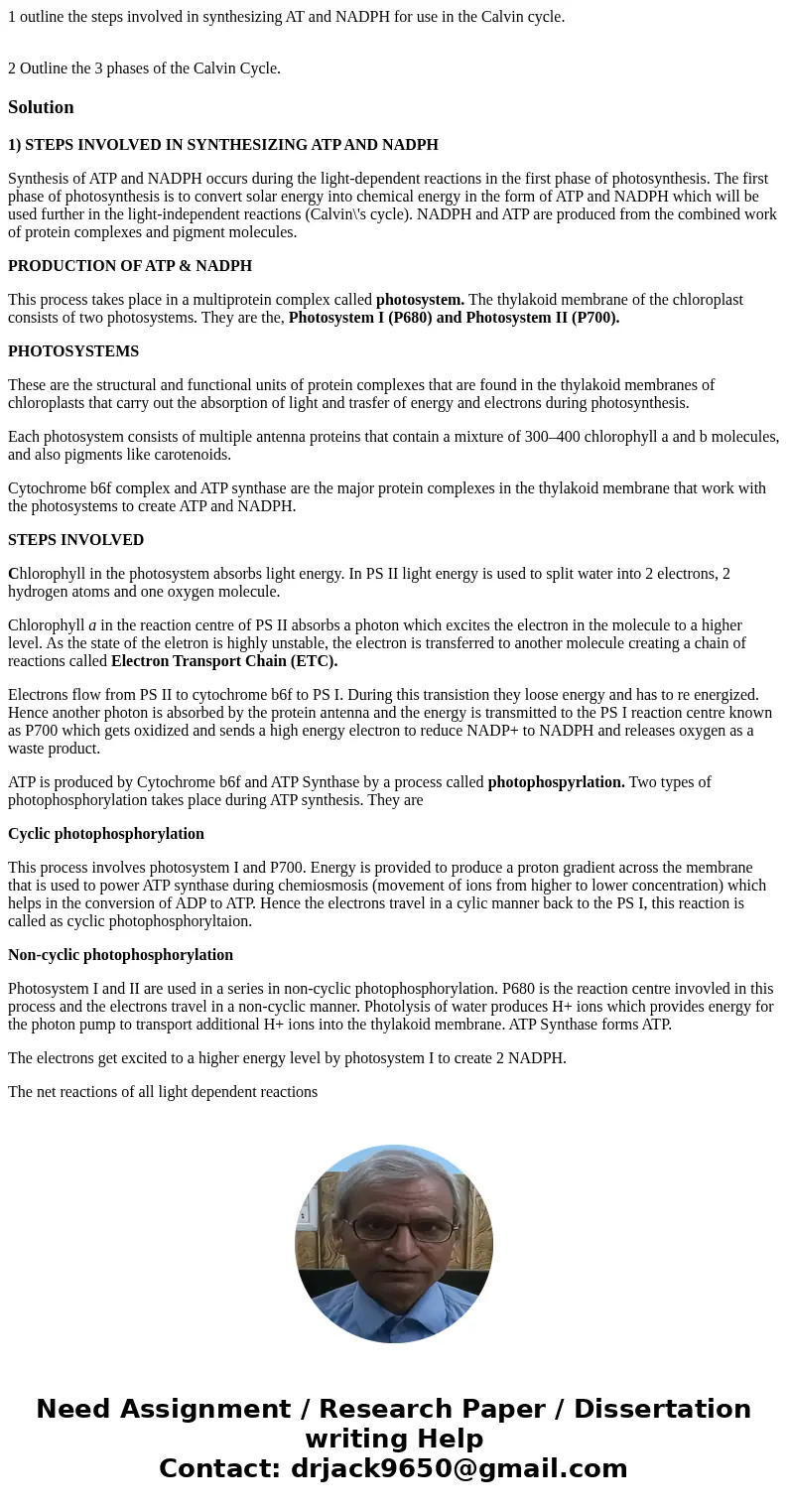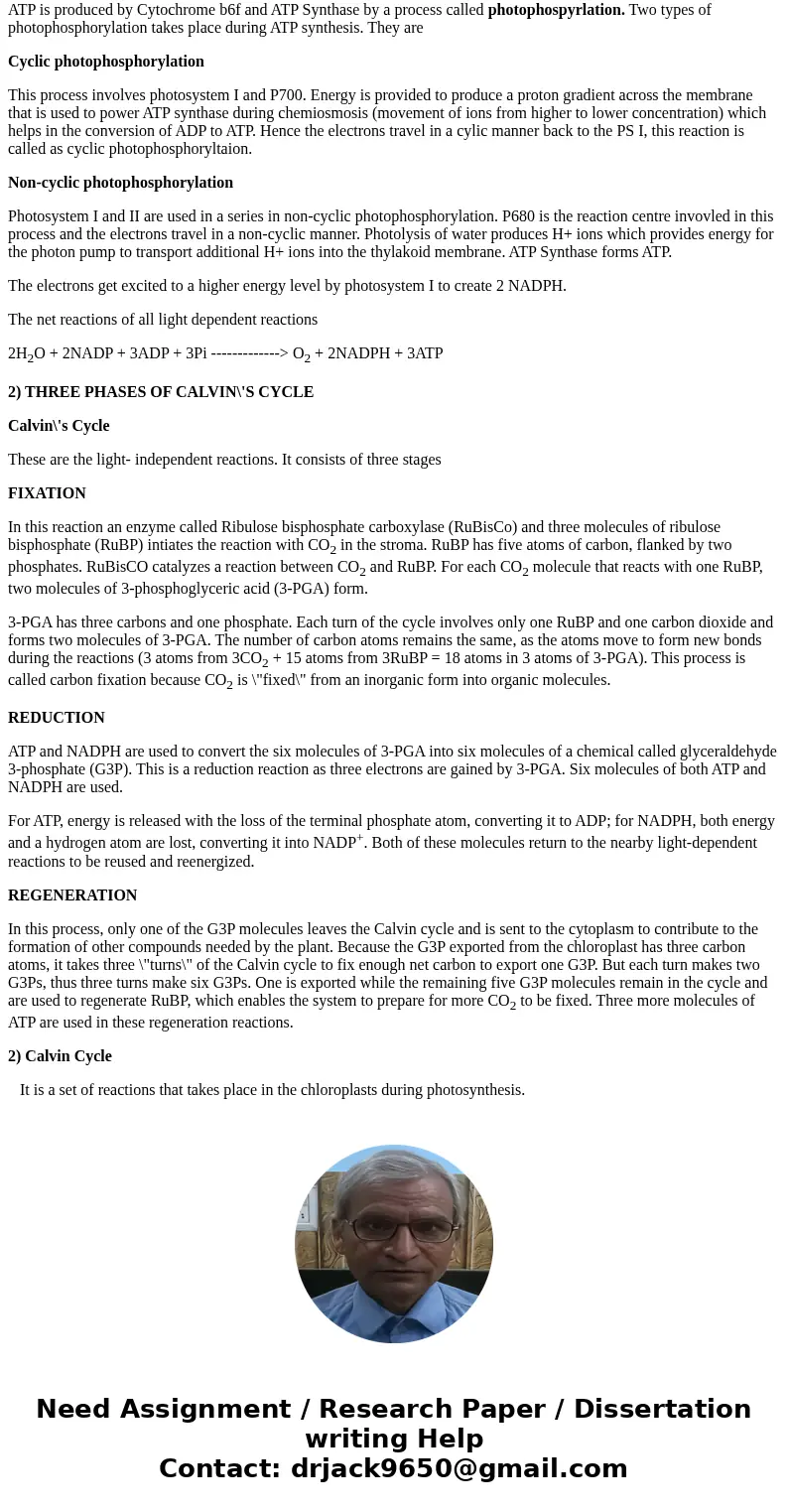1 outline the steps involved in synthesizing AT and NADPH fo
1 outline the steps involved in synthesizing AT and NADPH for use in the Calvin cycle.
2 Outline the 3 phases of the Calvin Cycle.
Solution
1) STEPS INVOLVED IN SYNTHESIZING ATP AND NADPH
Synthesis of ATP and NADPH occurs during the light-dependent reactions in the first phase of photosynthesis. The first phase of photosynthesis is to convert solar energy into chemical energy in the form of ATP and NADPH which will be used further in the light-independent reactions (Calvin\'s cycle). NADPH and ATP are produced from the combined work of protein complexes and pigment molecules.
PRODUCTION OF ATP & NADPH
This process takes place in a multiprotein complex called photosystem. The thylakoid membrane of the chloroplast consists of two photosystems. They are the, Photosystem I (P680) and Photosystem II (P700).
PHOTOSYSTEMS
These are the structural and functional units of protein complexes that are found in the thylakoid membranes of chloroplasts that carry out the absorption of light and trasfer of energy and electrons during photosynthesis.
Each photosystem consists of multiple antenna proteins that contain a mixture of 300–400 chlorophyll a and b molecules, and also pigments like carotenoids.
Cytochrome b6f complex and ATP synthase are the major protein complexes in the thylakoid membrane that work with the photosystems to create ATP and NADPH.
STEPS INVOLVED
Chlorophyll in the photosystem absorbs light energy. In PS II light energy is used to split water into 2 electrons, 2 hydrogen atoms and one oxygen molecule.
Chlorophyll a in the reaction centre of PS II absorbs a photon which excites the electron in the molecule to a higher level. As the state of the eletron is highly unstable, the electron is transferred to another molecule creating a chain of reactions called Electron Transport Chain (ETC).
Electrons flow from PS II to cytochrome b6f to PS I. During this transistion they loose energy and has to re energized. Hence another photon is absorbed by the protein antenna and the energy is transmitted to the PS I reaction centre known as P700 which gets oxidized and sends a high energy electron to reduce NADP+ to NADPH and releases oxygen as a waste product.
ATP is produced by Cytochrome b6f and ATP Synthase by a process called photophospyrlation. Two types of photophosphorylation takes place during ATP synthesis. They are
Cyclic photophosphorylation
This process involves photosystem I and P700. Energy is provided to produce a proton gradient across the membrane that is used to power ATP synthase during chemiosmosis (movement of ions from higher to lower concentration) which helps in the conversion of ADP to ATP. Hence the electrons travel in a cylic manner back to the PS I, this reaction is called as cyclic photophosphoryltaion.
Non-cyclic photophosphorylation
Photosystem I and II are used in a series in non-cyclic photophosphorylation. P680 is the reaction centre invovled in this process and the electrons travel in a non-cyclic manner. Photolysis of water produces H+ ions which provides energy for the photon pump to transport additional H+ ions into the thylakoid membrane. ATP Synthase forms ATP.
The electrons get excited to a higher energy level by photosystem I to create 2 NADPH.
The net reactions of all light dependent reactions
2H2O + 2NADP + 3ADP + 3Pi -------------> O2 + 2NADPH + 3ATP
2) THREE PHASES OF CALVIN\'S CYCLE
Calvin\'s Cycle
These are the light- independent reactions. It consists of three stages
FIXATION
In this reaction an enzyme called Ribulose bisphosphate carboxylase (RuBisCo) and three molecules of ribulose bisphosphate (RuBP) intiates the reaction with CO2 in the stroma. RuBP has five atoms of carbon, flanked by two phosphates. RuBisCO catalyzes a reaction between CO2 and RuBP. For each CO2 molecule that reacts with one RuBP, two molecules of 3-phosphoglyceric acid (3-PGA) form.
3-PGA has three carbons and one phosphate. Each turn of the cycle involves only one RuBP and one carbon dioxide and forms two molecules of 3-PGA. The number of carbon atoms remains the same, as the atoms move to form new bonds during the reactions (3 atoms from 3CO2 + 15 atoms from 3RuBP = 18 atoms in 3 atoms of 3-PGA). This process is called carbon fixation because CO2 is \"fixed\" from an inorganic form into organic molecules.
REDUCTION
ATP and NADPH are used to convert the six molecules of 3-PGA into six molecules of a chemical called glyceraldehyde 3-phosphate (G3P). This is a reduction reaction as three electrons are gained by 3-PGA. Six molecules of both ATP and NADPH are used.
For ATP, energy is released with the loss of the terminal phosphate atom, converting it to ADP; for NADPH, both energy and a hydrogen atom are lost, converting it into NADP+. Both of these molecules return to the nearby light-dependent reactions to be reused and reenergized.
REGENERATION
In this process, only one of the G3P molecules leaves the Calvin cycle and is sent to the cytoplasm to contribute to the formation of other compounds needed by the plant. Because the G3P exported from the chloroplast has three carbon atoms, it takes three \"turns\" of the Calvin cycle to fix enough net carbon to export one G3P. But each turn makes two G3Ps, thus three turns make six G3Ps. One is exported while the remaining five G3P molecules remain in the cycle and are used to regenerate RuBP, which enables the system to prepare for more CO2 to be fixed. Three more molecules of ATP are used in these regeneration reactions.
2) Calvin Cycle
It is a set of reactions that takes place in the chloroplasts during photosynthesis.


 Homework Sourse
Homework Sourse